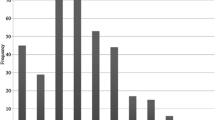Abstract
Purpose
Studies on the influence of CO2 pneumoperitoneum on the abdominal cavity during robotic procedures are lacking. This is the first study to evaluate surgical field modifications related to CO2 pressure, during laparoscopic and robotic surgery.
Methods
Consecutive patients scheduled for laparoscopic or robotic hysterectomy were enrolled in the study. To evaluate the level of operative field visualization, a dedicated form has been designed based on the evaluation of four different areas: Douglas space, vesico-uterine fold and, bilaterally, the broad ligament. During the initial inspection, an assistant randomly set the CO2 pressure at 15, 10 and 5 mmHg, and the surgeon, not aware of the CO2 values, was asked to give an evaluation of the four areas for each set pressure.
Results
In laparoscopic group, CO2 pressure significantly influenced the surgical field visualization in all four areas analyzed. The surgeon had a good visualization only at 15 mmHg CO2 pressure; visualization decreased with a statistically significant difference from 15 to 5, 15–10 and 10–5 mmHg. In robotic group, influence of CO2 pressure on surgical areas visualization was not straightforward; operative field visualization remained stable at any pressure value with no significant difference.
Conclusions
Pneumoperitoneum pressure significantly affects the visualization of the abdomino-pelvic cavity in laparoscopic procedures. Otherwise, CO2 pressure does not affect the visualization of surgical field during robotic surgery. These findings are particularly significant especially at low CO2 pressure with potential implications on peritoneal environment and the subsequent post-operative patient recovery.



Similar content being viewed by others
References
Volz J, Köster S, Weiss M, Schmidt R, Urbaschek R, Melchert F, Albrecht M (1996) Pathophysiologic features of a pneumoperitoneum at laparoscopy: a swine model. Am J Obstet Gynecol 174:132–140
Payne TN, Dauterive FR (2008) A comparison of total laparoscopic hysterectomy to robotically assisted hysterectomy: surgical outcomes in community practice. J Minim Invasive Gynecol. 15(3):286–291
Russell RC (1993) General surgery: biliary surgery. BMJ 307(6914):1266–1269
Bocca S, Stadtmauer L, Oehninger S (2007) Current status of robotically assisted laparoscopic surgery in reproductive medicine and gynaecology. Reprod Biomed Online 6:765–772
Sarlos D, Kots L, Stevanovic N, von Felten S, Schär G (2012) Robotic compared with conventional laparoscopic hysterectomy. Obstet Gynecol 120:604–611
Rosário MT, Ribeiro U Jr, Corbett CE, Ozaki AC, Bresciani CC, Zilberstein B, Gama-Rodrigues JJ (2006) Does CO2 pneumoperitoneum alter the ultra-structure of the mesothelium? J Surg Res 2:84–88
Walsh CA, Walsh SR, Tang TY, Slack M (2009) Total abdominal hysterectomy versus total laparoscopic hysterectomy for benign disease: a meta-analysis. Eur J Obstet Gynecol Reprod Biol 144:3–7
Holmdahl L (2000) The plasmin system, a marker of the propensity to develop adhesions. In: DiZerega G et al (eds) Peritoneal surgery. Springer, New York, pp 117–131
Cevrioglu AS, Yilmaz S, Koken T, Tokyol C, Yilmazer M, Fenkci IV (2004) Comparison of the effects of low intra-abdominal pressure and ischaemic preconditioning on the generation of oxidative stress markers and inflammatory cytokines during laparoscopy in rats. Hum Reprod 9:2144–2151
Ott DE (2003) Desertification of the peritoneum by thin-film evaporation during laparoscopy. JSLS 7:189–195
Sammour T, Kahokehr A, Hill A (2008) Meta-analysis of the effect of warm humidified insufflation on pain after laparoscopy. Br J Surg 95:950–956
Matsuzaki S, Jardon K, Maleysson E, D’Arpiany F, Canis M, Botchorishvili R (2012) Impact of intraperitoneal pressure of a CO2 pneumoperitoneum on the surgical peritoneal environment. Hum Reprod 27:1613–1623
Binda M, Koninckx P (2009) Prevention of adhesions formation in a laparoscopic mouse model should combine local treatment with peritoneal cavity conditioning. Hum Reprod 24:1473–1479
Shashoua AR, Gill D, Locher SR (2009) Robotic-assisted total laparoscopic hysterectomy versus conventional total laparoscopic hysterectomy. JSLS 3:364–369
Pluchino N, Litta P, Freschi L, Russo M, Simi G, Santoro AN, Angioni S, Gadducci A, Cela V (2014) Comparison of the initial surgical experience with robotic and laparoscopic myomectomy. Int J Med Robot 10(2):208–212
Litta P, Saccardi C, Conte L, Florio P (2013) Reverse hysterectomy: another technique for performing a laparoscopic hysterectomy. J Minim Invasive Gynecol 20(5):631–636
Ciavattini A, Di Giuseppe J, Cecchi S, Tsiroglou D, Mancioli F, Stevenazzi G, Tranquilli AL, Litta P (2014) Gynecologic laparoscopy in patients aged 65 or more: feasibility and safety in the presence of increased comorbidity. Eur J Obstet Gynecol Reprod Biol 175:49–53
Litta P, Fabris AM, Breda E, Bartolucci C, Conte L, Saccardi C, Nappi L (2013) Laparoscopic surgical staging of endometrial cancer: does obesity influence feasibility and perioperative outcome? Eur J Gynaecol Oncol 34(3):231–233
Conflict of interest
The authors have no conflicts of interest or financial ties to disclose.
Author information
Authors and Affiliations
Corresponding author
Rights and permissions
About this article
Cite this article
Angioli, R., Terranova, C., Plotti, F. et al. Influence of pneumoperitoneum pressure on surgical field during robotic and laparoscopic surgery: a comparative study. Arch Gynecol Obstet 291, 865–868 (2015). https://doi.org/10.1007/s00404-014-3494-z
Received:
Accepted:
Published:
Issue Date:
DOI: https://doi.org/10.1007/s00404-014-3494-z



